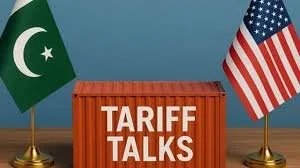Why the likely Pak-US trade framework could be a turning point
By The Taurean
As Pakistan and the US edge closer to an understanding on trading, the outlines of the emerging agreement present an economic opportunity — and also a test of long-term policy vision
STATE OF THE NATION
July 5, 2025
THIS past week’s trade discussions between Pakistan and the United States in Washington could mark a critical shift in Pakistan’s external economic engagement — if early reports prove accurate, and if the deal is implemented with strategic clarity.
According to a report in Dawn, the Pakistani delegation led by Commerce Secretary Jawad Paal arrived in the US capital seeking to secure a reciprocal tariff arrangement before a 9th July deadline that threatened the return of steep 29 per cent duties on key Pakistani exports, notably textiles and agricultural goods. While no formal announcement has been made, sources suggest the outlines of a deal have been agreed upon — one that not only protects current market access but also opens the door to enhanced trade and investment ties.
Though details remain under wraps pending Washington’s conclusion of parallel talks with other countries, early indications point to a framework that would preserve tariff relief for Pakistani goods while increasing Pakistan’s imports of American products, particularly crude oil.
Discussions reportedly touched on US investment in sectors such as mining, energy, and infrastructure — including interest in the Reko Diq mining project and broader energy-related developments.
This is promising. For too long, Pakistan’s trade relationship with the US — its single largest export destination — has lacked strategic depth. A long-term tariff agreement, if coupled with broader engagement through institutions like the US Export-Import Bank, could provide stability for exporters and investors alike.
But there is reason for cautious optimism rather than celebration. Past trade understandings have faltered due to bureaucratic inertia or shifts in political will. Moreover, it remains unclear how much of the agreement will translate into immediate investment flows, or whether promises of market access will be matched by structural reforms at home.
Another question is whether the deal will be embedded in a broader economic policy that aims for sustainable industrial growth, not just short-term relief from tariff shocks.
Still, if this framework evolves into a durable trade partnership, it may offer Pakistan not just economic breathing room but also the opportunity to reposition itself in an increasingly competitive global market.
The challenge now is to follow through — with transparency, coordination, and a clear vision for what Pakistan wants from its largest trading partner.
